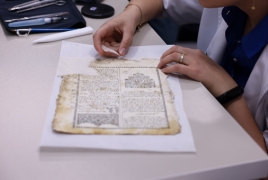
The Mesrop Mashtots Institute of Ancient Manuscripts (Matenadaran) has launched the production of manuscript restoration paper using locally sourced materials.
The opening ceremony of the newly established production unit was attended by Minister of Education, Science, Culture and Sports Zhanna Andreasyan, EU Ambassador to Armenia Vassilis Maragos, Matenadaran Director Ara Khzmalyan, and representatives from several partner institutions.
Minister Andreasyan highlighted the occasion by stating, “There is always something positive happening at Matenadaran, continuously revealing new layers of its potential and confirming that the scope of activity here knows no bounds. Matenadaran is more than a repository or research center—it is a space for experience and opportunity. The launch of Armenian-made restoration paper marks a promising development path.” She expressed gratitude to those behind the initiative for their innovative approach.
Director Ara Khzmalyan stressed the historical significance of this step for the institution. “Matenadaran is not just about preserving the treasures within its own walls. It also restores the documentary heritage of all Armenian libraries and museums,” he noted, thanking all the organizations that contributed to the project’s realization.
Khzmalyan added that with ministerial support, new positions for restoration specialists have been created, enhancing Matenadaran’s technical capacity amid growing volumes of material requiring conservation.
During the event, Khzmalyan presented certificates of appreciation to organizations that facilitated the successful launch. Thanks to extensive research and testing by the restoration department, a paper has been developed that matches the quality of widely used Japanese restoration paper, but is made from local raw materials.
The project was co-funded by the Armenia Tree Project charitable foundation, the EU-funded #EU4Culture program (main partner: Goethe-Institut), the Impact Hub Armenia Social Innovation Development Foundation, and Matenadaran. It began with a memorandum of cooperation between Matenadaran and the Armenia Tree Project, which included the planting of up to 100 trees.

